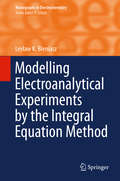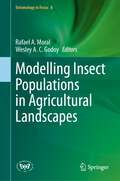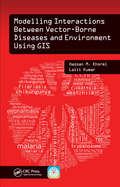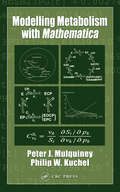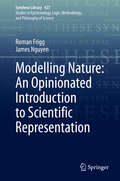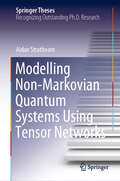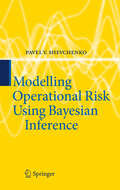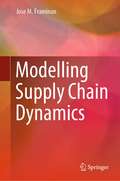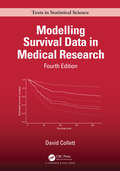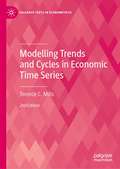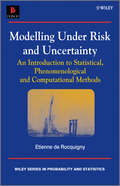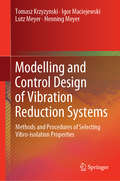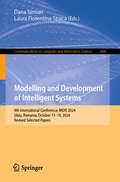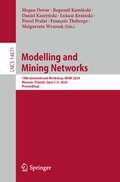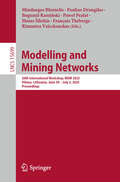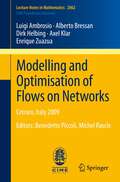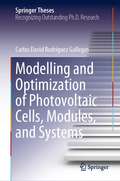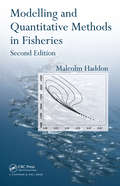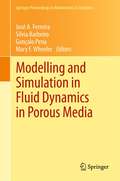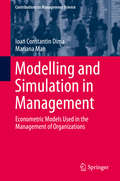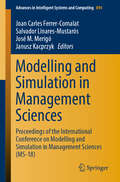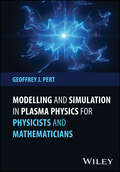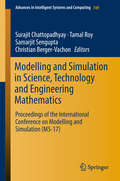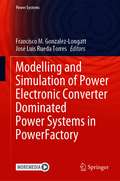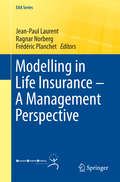- Table View
- List View
Modelling Electroanalytical Experiments by the Integral Equation Method
by Lesław K. BieniaszThis comprehensive presentation of the integral equation method as applied to electro-analytical experiments is suitable for electrochemists, mathematicians and industrial chemists. The discussion focuses on how integral equations can be derived for various kinds of electroanalytical models. The book begins with models independent of spatial coordinates, goes on to address models in one dimensional space geometry and ends with models dependent on two spatial coordinates. Bieniasz considers both semi-infinite and finite spatial domains as well as ways to deal with diffusion, convection, homogeneous reactions, adsorbed reactants and ohmic drops. Bieniasz also discusses mathematical characteristics of the integral equations in the wider context of integral equations known in mathematics. Part of the book is devoted to the solution methodology for the integral equations. As analytical solutions are rarely possible, attention is paid mostly to numerical methods and relevant software. This book includes examples taken from the literature and a thorough literature overview with emphasis on crucial aspects of the integral equation methodology.
Modelling Insect Populations in Agricultural Landscapes (Entomology in Focus #8)
by Rafael A. Moral Wesley A. C. GodoyThis book combines chapters emphasising mathematical, statistical, and computational modelling applied to insect populations, particularly pests or natural enemies in agricultural landscapes. There is a gap between agricultural pest experimentation and ecological theory, which requires a connection to supply models with laboratory, and field estimates and projects receiving inputs and insights from models. In addition, decision-making in entomology with respect to pest management and biological conservation of natural enemies has been supported by results obtained from different computational and mathematical approaches. This book brings contemporary issues related to optimization in spatially structured landscapes, insect movement, stability analysis, game theory, machine learning, computer vision, Bayesian modelling, as well as other frameworks.
Modelling Interactions Between Vector-Borne Diseases and Environment Using GIS
by Hassan M. KhormiMaster GIS Applications on Modelling and Mapping the Risks of DiseasesInfections transmitted by mosquitoes, ticks, triatomine bugs, sandflies, and black flies cause significant rates of death and disease, especially in developing countries. Why are certain places more susceptible to vector-borne diseases? Modelling Interactions Between Vector-Borne
Modelling Metabolism with Mathematica
by Peter Mulquiney Philip W. KuchelWith the advent of sophisticated general programming environments like Mathematica, the task of developing new models of metabolism and visualizing their responses has become accessible to students of biochemistry and the life sciences in general. Modelling Metabolism with Mathematica presents the approaches, methods, tools, and algorithms for mode
Modelling Nature: An Opinionated Introduction to Scientific Representation (Synthese Library #427)
by Roman Frigg James NguyenThis monograph offers a critical introduction to current theories of how scientific models represent their target systems. Representation is important because it allows scientists to study a model to discover features of reality. The authors provide a map of the conceptual landscape surrounding the issue of scientific representation, arguing that it consists of multiple intertwined problems. They provide an encyclopaedic overview of existing attempts to answer these questions, and they assess their strengths and weaknesses. The book also presents a comprehensive statement of their alternative proposal, the DEKI account of representation, which they have developed over the last few years. They show how the account works in the case of material as well as non-material models; how it accommodates the use of mathematics in scientific modelling; and how it sheds light on the relation between representation in science and art. The issue of representation has generated a sizeable literature, which has been growing fast in particular over the last decade. This makes it hard for novices to get a handle on the topic because so far there is no book-length introduction that would guide them through the discussion. Likewise, researchers may require a comprehensive review that they can refer to for critical evaluations. This book meets the needs of both groups.
Modelling Non-Markovian Quantum Systems Using Tensor Networks (Springer Theses)
by Aidan StrathearnThis thesis presents a revolutionary technique for modelling the dynamics of a quantum system that is strongly coupled to its immediate environment. This is a challenging but timely problem. In particular it is relevant for modelling decoherence in devices such as quantum information processors, and how quantum information moves between spatially separated parts of a quantum system.The key feature of this work is a novel way to represent the dynamics of general open quantum systems as tensor networks, a result which has connections with the Feynman operator calculus and process tensor approaches to quantum mechanics. The tensor network methodology developed here has proven to be extremely powerful: For many situations it may be the most efficient way of calculating open quantum dynamics. This work is abounds with new ideas and invention, and is likely to have a very significant impact on future generations of physicists.
Modelling Operational Risk Using Bayesian Inference
by Pavel V. ShevchenkoThe management of operational risk in the banking industry has undergone explosive changes over the last decade due to substantial changes in the operational environment. Globalization, deregulation, the use of complex financial products, and changes in information technology have resulted in exposure to new risks which are very different from market and credit risks. In response, the Basel Committee on Banking Supervision has developed a new regulatory framework for capital measurement and standards for the banking sector. This has formally defined operational risk and introduced corresponding capital requirements. Many banks are undertaking quantitative modelling of operational risk using the Loss Distribution Approach (LDA) based on statistical quantification of the frequency and severity of operational risk losses. There are a number of unresolved methodological challenges in the LDA implementation. Overall, the area of quantitative operational risk is very new and different methods are under hot debate. This book is devoted to quantitative issues in LDA. In particular, the use of Bayesian inference is the main focus. Though it is very new in this area, the Bayesian approach is well suited for modelling operational risk, as it allows for a consistent and convenient statistical framework for quantifying the uncertainties involved. It also allows for the combination of expert opinion with historical internal and external data in estimation procedures. These are critical, especially for low-frequency/high-impact operational risks. This book is aimed at practitioners in risk management, academic researchers in financial mathematics, banking industry regulators and advanced graduate students in the area. It is a must-read for anyone who works, teaches or does research in the area of financial risk.
Modelling Supply Chain Dynamics
by Jose M. FraminanThis book discusses supply chain management, focusing on developments within modelling the dynamic behaviour of the supply chain. Aimed at postgraduate students, researchers and practitioners, this book provides an in-depth knowledge of the dynamics of supply chains. Business trends such as the globalisation process and the increase of competition across many industrial sectors have forced companies to concentrate on their core competences and to outsource those activities in which they do not excel. As a consequence, companies no longer produce and distribute their goods in isolation, but being part of a supply chain or supply network, i.e. a set of interrelated companies who ultimately deliver the goods and services to the final customer. Despite the prevalence of supply chains as the primary form of production and distribution, their performance can be seriously hampered by the complex dynamics resulting from the collaboration and coordination (or lack thereof) among their members.This book provides the reader with modelling tools to understand, analyse and improve the dynamic behaviour of supply chains. It assembles seminal works on supply chain models and recent developments on the topic in order to provide a comprehensive, unified vision of the field for researchers and practitioners who wish to grasp the challenges of supply chain management. Aside presenting the main elements, equations and performance indicators governing the dynamics of a supply chain, and the book addresses issues such as the effect of timely and accurately sharing the information across members, the influence of restrictions on the productive capacities of their members, or the impact of the variability of the lead times, among others. Furthermore, more complex supply chain structures such as non-serial supply networks or closed-loop supply chains are modelled and discussed. Relevant managerial insights regarding the causes of supply chain underperformance, as well as avenues to improve their efficiency can be extracted from the resulting models.
Modelling Survival Data in Medical Research (Chapman & Hall/CRC Texts in Statistical Science)
by David CollettModelling Survival Data in Medical Research, Fourth Edition, describes the analysis of survival data, illustrated using a wide range of examples from biomedical research. Written in a non-technical style, it concentrates on how the techniques are used in practice. Starting with standard methods for summarising survival data, Cox regression and parametric modelling, the book covers many more advanced techniques, including interval-censoring, frailty modelling, competing risks, analysis of multiple events, and dependent censoring. This new edition contains chapters on Bayesian survival analysis and use of the R software. Earlier chapters have been extensively revised and expanded to add new material on several topics. These include methods for assessing the predictive ability of a model, joint models for longitudinal and survival data, and modern methods for the analysis of interval-censored survival data. Features: Presents an accessible account of a wide range of statistical methods for analysing survival data Contains practical guidance on modelling survival data from the author’s many years of experience in teaching and consultancy Shows how Bayesian methods can be used to analyse survival data Includes details on how R can be used to carry out all the methods described, with guidance on the interpretation of the resulting output Contains many real data examples and additional data sets that can be used for coursework All data sets used are available in electronic format from the publisher’s website Modelling Survival Data in Medical Research, Fourth Edition, is an invaluable resource for statisticians in the pharmaceutical industry and biomedical research centres, research scientists and clinicians who are analysing their own data, and students following undergraduate or postgraduate courses in survival analysis.
Modelling Trends and Cycles in Economic Time Series (Palgrave Texts in Econometrics)
by Terence C. MillsModelling trends and cycles in economic time series has a long history, with the use of linear trends and moving averages forming the basic tool kit of economists until the 1970s. Several developments in econometrics then led to an overhaul of the techniques used to extract trends and cycles from time series. In this second edition, Terence Mills expands on the research in the area of trends and cycles over the last (almost) two decades, to highlight to students and researchers the variety of techniques and the considerations that underpin their choice for modelling trends and cycles.
Modelling Under Risk and Uncertainty
by Etienne De RocquignyModelling has permeated virtually all areas of industrial, environmental, economic, bio-medical or civil engineering: yet the use of models for decision-making raises a number of issues to which this book is dedicated:How uncertain is my model ? Is it truly valuable to support decision-making ? What kind of decision can be truly supported and how can I handle residual uncertainty ? How much refined should the mathematical description be, given the true data limitations ? Could the uncertainty be reduced through more data, increased modeling investment or computational budget ? Should it be reduced now or later ? How robust is the analysis or the computational methods involved ? Should / could those methods be more robust ? Does it make sense to handle uncertainty, risk, lack of knowledge, variability or errors altogether ? How reasonable is the choice of probabilistic modeling for rare events ? How rare are the events to be considered ? How far does it make sense to handle extreme events and elaborate confidence figures ? Can I take advantage of expert / phenomenological knowledge to tighten the probabilistic figures ? Are there connex domains that could provide models or inspiration for my problem ?Written by a leader at the crossroads of industry, academia and engineering, and based on decades of multi-disciplinary field experience, Modelling Under Risk and Uncertainty gives a self-consistent introduction to the methods involved by any type of modeling development acknowledging the inevitable uncertainty and associated risks. It goes beyond the "black-box" view that some analysts, modelers, risk experts or statisticians develop on the underlying phenomenology of the environmental or industrial processes, without valuing enough their physical properties and inner modelling potential nor challenging the practical plausibility of mathematical hypotheses; conversely it is also to attract environmental or engineering modellers to better handle model confidence issues through finer statistical and risk analysis material taking advantage of advanced scientific computing, to face new regulations departing from deterministic design or support robust decision-making.Modelling Under Risk and Uncertainty:Addresses a concern of growing interest for large industries, environmentalists or analysts: robust modeling for decision-making in complex systems.Gives new insights into the peculiar mathematical and computational challenges generated by recent industrial safety or environmental control analysis for rare events. Implements decision theory choices differentiating or aggregating the dimensions of risk/aleatory and epistemic uncertainty through a consistent multi-disciplinary set of statistical estimation, physical modelling, robust computation and risk analysis.Provides an original review of the advanced inverse probabilistic approaches for model identification, calibration or data assimilation, key to digest fast-growing multi-physical data acquisition.Illustrated with one favourite pedagogical example crossing natural risk, engineering and economics, developed throughout the book to facilitate the reading and understanding.Supports Master/PhD-level course as well as advanced tutorials for professional trainingAnalysts and researchers in numerical modeling, applied statistics, scientific computing, reliability, advanced engineering, natural risk or environmental science will benefit from this book.
Modelling and Control Design of Vibration Reduction Systems: Methods And Procedures Of Selecting Vibro-isolation Properties
by Henning Meyer Tomasz Krzyzynski Igor Maciejewski Lutz MeyerThis book describes the modelling and optimisation of vibration reduction systems in an integrated fashion using nonlinear equations of motion. It proposes an effective optimisation method for determining the basic characteristics of the non-linear visco-elastic elements used in passive vibration reduction systems. In the case of semi-active and active vibration isolators, a design process of the advanced control systems is proposed that makes possible to optimise the controller settings relatively to the selected vibro-isolation criteria. The approach developed here is subsequently tested by means of experimental investigations conducted on various sample vibration reduction systems: passive, semi-active and active. The book presents a biomechanical modelling approach that allows users to select the properties of vibro-isolation systems for different types of oscillation and different optimisation criteria – and can significantly reduce the harmful vibrations that can affect the human body in the process. Further, the book equips readers to evaluate the viscoelastic characteristics of passive systems and design control systems for semi-active and active systems. Modelling and Control Design of Vibration Reduction Systems offers a valuable guide for researchers and practitioners alike. It also provides students and academics with systematic information on the procedures to be followed in the design process for semi-active or active vibration reduction systems.
Modelling and Development of Intelligent Systems: 9th International Conference, MDIS 2024, Sibiu, Romania, October 17–19, 2024, Revised Selected Papers (Communications in Computer and Information Science #2486)
by Dana Simian Laura Florentina StoicaThis book CCIS 2486 constitutes the refereed proceedings of the 9th International Conference on Modelling and Development of Intelligent Systems, MDIS 2024, held in Sibiu, Romania, during October 17–19, 2024. The 16 full papers were carefully reviewed and selected from 42 submissions. The MDIS 2024 focuses on Machine Learning, Intelligent Systems for Decision supports, Modelling and optimization of Dynamic Systems, Evolutionary Computing and Metaheuristics, Security and Cryptography in Dynamic Systems.
Modelling and Mining Networks: 19th International Workshop, WAW 2024, Warsaw, Poland, June 3–6, 2024, Proceedings (Lecture Notes in Computer Science #14671)
by Megan Dewar Bogumił Kamiński Paweł Prałat François Théberge Małgorzata Wrzosek Daniel Kaszyński Łukasz KraińskiThis book constitutes the refereed proceedings of the 19th International Workshop on Modelling and Mining Networks, WAW 2024, held in Warsaw, Poland, during June 3–6, 2024. The 12 full papers presented in this book were carefully reviewed and selected from 19 submissions. The aim of this workshop was to further the understanding of networks that arise in theoretical as well as applied domains. The goal was also to stimulate the development of high-performance and scalable algorithms that exploit these networks.
Modelling and Mining Networks: 20th International Workshop, WAW 2025, Vilnius, Lithuania, June 30 – July 3, 2025, Proceedings (Lecture Notes in Computer Science #15699)
by Bogumił Kamiński Paweł Prałat François Théberge Mindaugas Bloznelis Paulius Drungilas Matas Šileikis Rimantas VaicekauskasThis book constitutes the refereed proceedings of the 20th International Workshop on Modelling and Mining Networks, WAW 2025, held in Vilnius, Lithuania, during June 30–July 3, 2025.The 13 full papers presented in this book were carefully reviewed and selected from 20 submissions.The aim of the 20th Workshop on Modelling and Mining Networks was to further the understanding of networks that arise in theoretical as well as applied domains. The goal was also to stimulate the development of high performance and scalable algorithms that exploit these networks.
Modelling and Optimisation of Flows on Networks
by Enrique Zuazua Dirk Helbing Benedetto Piccoli Alberto Bressan Axel Klar Luigi Ambrosio Michel RascleIn recent years flows in networks have attracted the interest of many researchers from different areas, e.g. applied mathematicians, engineers, physicists, economists. The main reason for this ubiquity is the wide and diverse range of applications, such as vehicular traffic, supply chains, blood flow, irrigation channels, data networks and others. This book presents an extensive set of notes by world leaders on the main mathematical techniques used to address such problems, together with investigations into specific applications. The main focus is on partial differential equations in networks, but ordinary differential equations and optimal transport are also included. Moreover, the modeling is completed by analysis, numerics, control and optimization of flows in networks. The book will be a valuable resource for every researcher or student interested in the subject.
Modelling and Optimization of Photovoltaic Cells, Modules, and Systems (Springer Theses)
by Carlos David Rodríguez GallegosThis book presents a study to determine the current limitations in the area of Photovoltaics (PV) as a source of renewable energy and proposes strategies to overcome them by applying optimization approaches in three main areas, namely related to photovoltaic solar cells, modules, and systems. These include grid metallization design of Si-based solar cells and modules; cost-effectiveness analysis between Si-based monofacial and bifacial grid-connected PV systems; optimal diesel replacement strategy for the progressive introduction of PV and batteries; dispatch strategy optimization for PV hybrid systems in real time. The novelty of the work presented in this book is of high interest to the scientific community but also to the PV manufacturers, installation companies, and investors.
Modelling and Quantitative Methods in Fisheries
by Malcolm HaddonWith numerous real-world examples, Modelling and Quantitative Methods in Fisheries, Second Edition provides an introduction to the analytical methods used by fisheries' scientists and ecologists. By following the examples using Excel, readers see the nuts and bolts of how the methods work and better understand the underlying principles. Excel workb
Modelling and Simulation in Fluid Dynamics in Porous Media
by Gonçalo Pena Mary F. Wheeler José A. Ferreira Sílvia BarbeiroThis volume presents a selection of survey and research articles based on invited lectures and contributed talks presented at the Workshop on Fluid Dynamics in Porous Media that was held in Coimbra, Portugal, in September 12-14, 2011. The contributions are devoted to mathematical modeling, numerical simulation and their applications, providing the readers a state-of-the-art overview on the latest findings and new challenges on the topic. The book includes research work of worldwide recognized leaders in their respective fields and presents advances in both theory and applications, making it appealing to a vast range of audience, in particular mathematicians, engineers and physicists.
Modelling and Simulation in Management
by Ioan Constantin Dima Mariana ManThis book is a comprehensive introduction of the reader into the simulation and modelling techniques and their application in the management of organisations. The book is rooted in the thorough understanding of systems theory applied to organisations and focuses on how this theory can apply to econometric models used in the management of organisations. The econometric models in this book employ linear and dynamic programming, graph theory, queuing theory, game theory, etc. and are presented and analysed in various fields of application, such as investment management, stock management, strategic decision making, management of production costs and the lifecycle costs of quality and non-quality products, production quality Management, etc.
Modelling and Simulation in Management Sciences: Proceedings of the International Conference on Modelling and Simulation in Management Sciences (MS-18) (Advances in Intelligent Systems and Computing #894)
by Janusz Kacprzyk Joan Carles Ferrer-Comalat Salvador Linares-Mustarós José M. MerigóThis book includes a collection of selected papers presented at the International Conference on Modelling and Simulation in Engineering, Economics, and Management, held at the Faculty of Economics and Business at the University of Girona, Spain, 28-29 June 2018.The conference was organized by the Association for the Advancement of Modelling and Simulation Techniques in Enterprises (AMSE) and the University of Girona with the aim of promoting research in the field of modelling, simulation and management science. This book presents original research studies related to fuzzy logic, soft computing and uncertainty, as well as a number of papers in the field of bibliometrics in social sciences. Presenting new advances in these areas, with a special focus on management, economics and social sciences.It is of great interest to researchers and Ph.D. students working in the field of fuzzy logic, soft computing, uncertainty and bibliometrics.
Modelling and Simulation in Plasma Physics for Physicists and Mathematicians
by Geoffrey J. PertUnveiling the Secrets of Plasma Physics: A Practical Guide to Computational Simulations Plasma physics focuses on the most abundant state of matter in the universe, corresponding to ionized gas comprising ions and electrons. It can be created artificially and has a huge range of technological applications, from television displays to fusion energy research. Every application of plasma technology requires its own numerical solution to the complex physical and mathematical equations which govern the research field of plasma physics. Modelling and Simulation in Plasma Physics for Physicists and Mathematics offers an introduction to the principles of simulating plasma physics applications. It provides knowledge not only of the fundamental algorithms in computational fluid mechanics, but also their specific role in a plasma physics context. In addition, the book dissects the challenges and advancements, unveiling the delicate balance between accuracy and computational cost. Modelling and Simulation in Plasma Physics for Physicists and Mathematics readers will also find: Cutting-edge computational insights where powerful simulations meet theoretical complexities, providing physicists and mathematicians a gateway to cutting-edge research. An overview of programming language-agnostic code generation and the construction of adaptable models that resonate with the intricate dynamics of plasma physics, ensuring precision in every simulation. Advanced simplification strategies, including time splitting, analytic models, averaged rates, and tabular material, offering scientists and engineers a roadmap to balance computational demands with scientific rigor. Modelling and Simulation in Plasma Physics for Physicists and Mathematics is ideal for plasma physicists, students, and engineers looking to work with plasma technologies.
Modelling and Simulation in Science, Technology and Engineering Mathematics: Proceedings Of International Conference On Modelling And Simulation (ms-17) (Advances In Intelligent Systems and Computing #749)
by Surajit Chattopadhyay Samarjit Sengupta Christian Berger-Vachon Tamal RoyThis volume contains the peer-reviewed proceedings of the International Conference on Modelling and Simulation (MS-17), held in Kolkata, India, 4th-5th November 2017, organized by the Association for the Advancement of Modelling and Simulation Techniques in Enterprises (AMSE, France) in association with the Institution of Engineering Technology (IET, UK), Kolkata Network. The contributions contained here showcase some recent advances in modelling and simulation across various aspects of science and technology. This book brings together articles describing applications of modelling and simulation techniques in fields as diverse as physics, mathematics, electrical engineering, industrial electronics, control, automation, power systems, energy and robotics. It includes a special section on mechanical, fuzzy, optical and opto-electronic control of oscillations. It provides a snapshot of the state of the art in modelling and simulation methods and their applications, and will be of interest to researchers and engineering professionals from industry, academia and research organizations.
Modelling and Simulation of Power Electronic Converter Dominated Power Systems in PowerFactory (Power Systems)
by Francisco M. Gonzalez-Longatt José Luis Rueda TorresThis book provides an overview of power electronic converters for numerical simulations based on DIgSILENT PowerFactory. It covers the working principles, key assumptions and implementation of models of different types of these power systems. The book is divided into three main parts: the first discusses high-voltage direct currents, while the second part examines distribution systems and micro-grids. Lastly, the third addresses the equipment and technologies used in modelling and simulation. Each chapter includes practical examples and exercises, and the accompanying software illustrates essential models, principles and performance using DIgSILENT PowerFactory. Exploring various current topics in the field of modelling power systems, this book will appeal to a variety of readers, ranging from students to practitioners.
Modelling in Life Insurance – A Management Perspective (EAA Series #0)
by Jean-Paul Laurent Ragnar Norberg Frédéric PlanchetFocusing on life insurance and pensions, this book addresses various aspects of modelling in modern insurance: insurance liabilities; asset-liability management; securitization, hedging, and investment strategies. With contributions from internationally renowned academics in actuarial science, finance, and management science and key people in major life insurance and reinsurance companies, there is expert coverage of a wide range of topics, for example: models in life insurance and their roles in decision making; an account of the contemporary history of insurance and life insurance mathematics; choice, calibration, and evaluation of models; documentation and quality checks of data; new insurance regulations and accounting rules; cash flow projection models; economic scenario generators; model uncertainty and model risk; model-based decision-making at line management level; models and behaviour of stakeholders. With author profiles ranging from highly specialized model builders to decision makers at chief executive level, this book should prove a useful resource to students and academics of actuarial science as well as practitioners.
